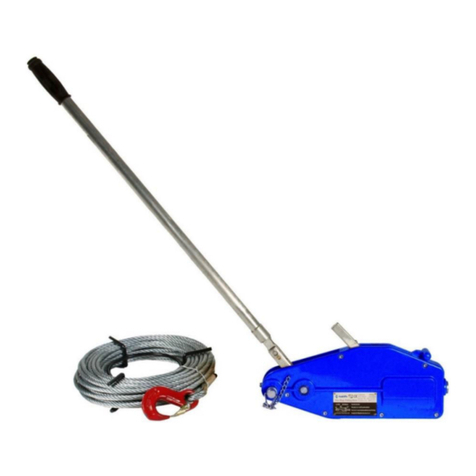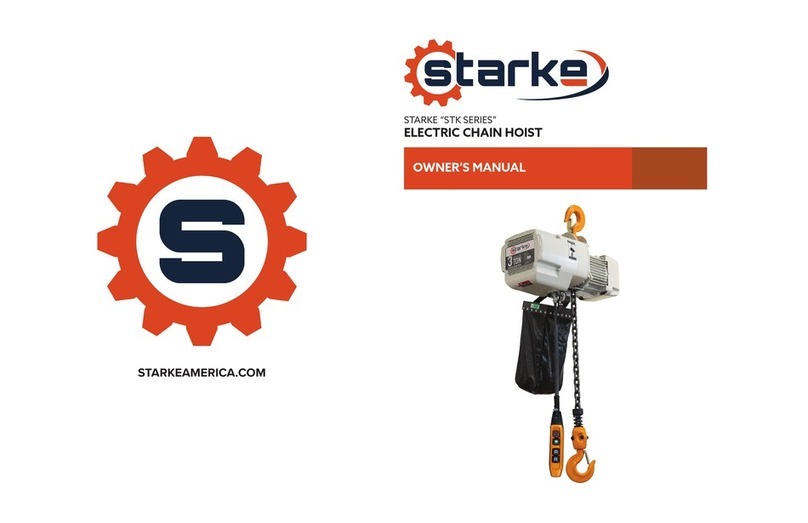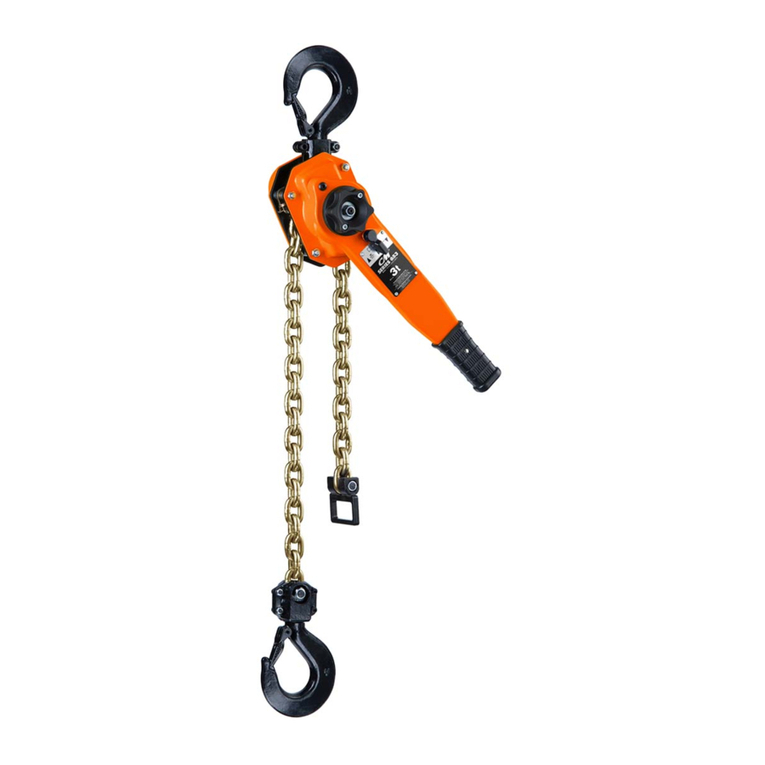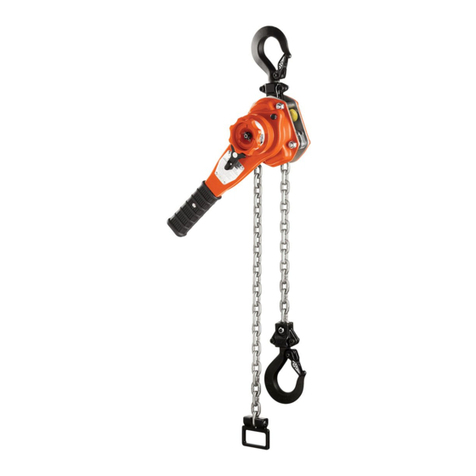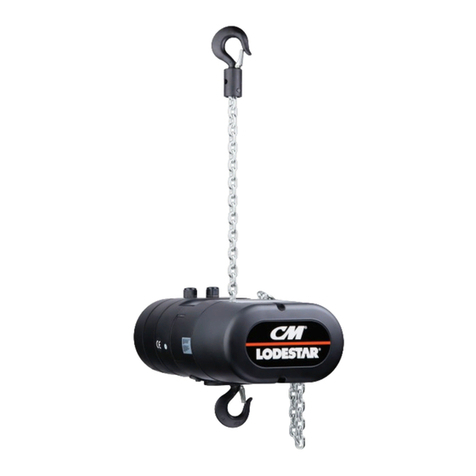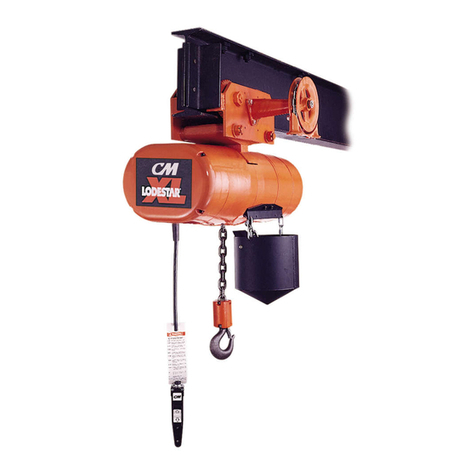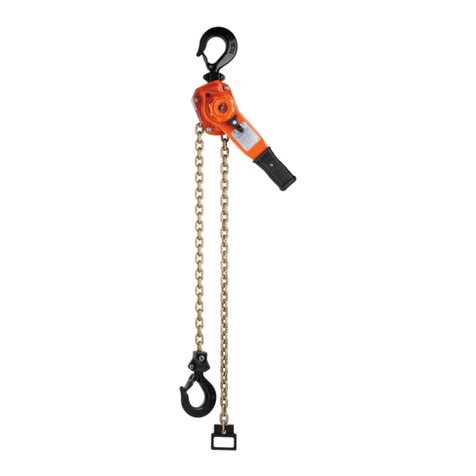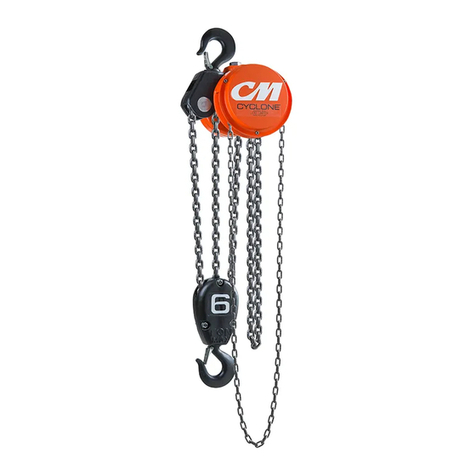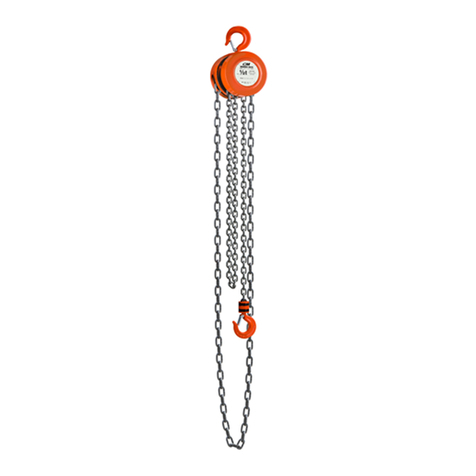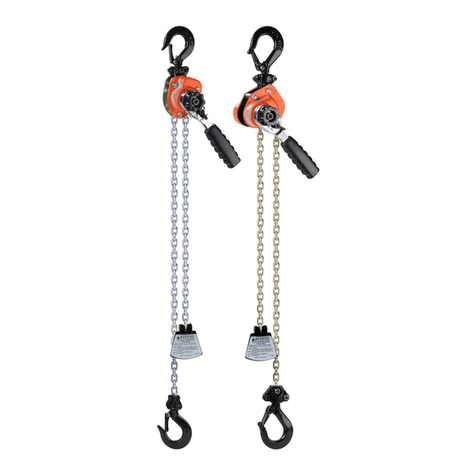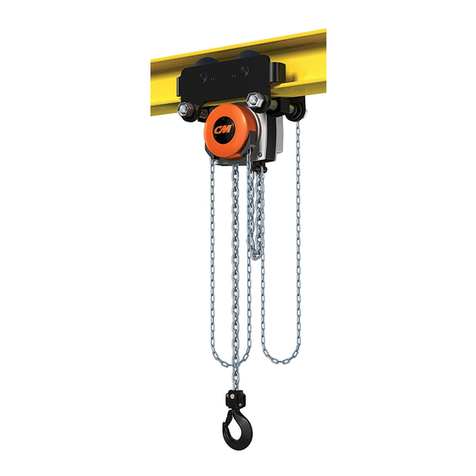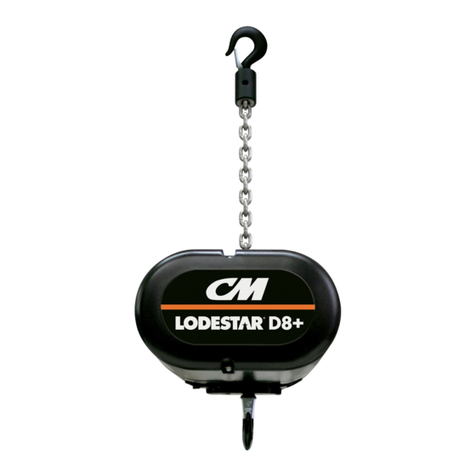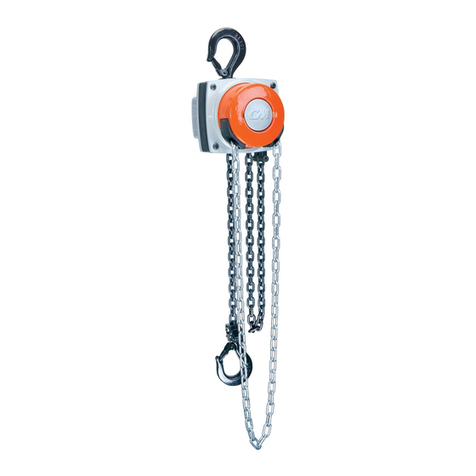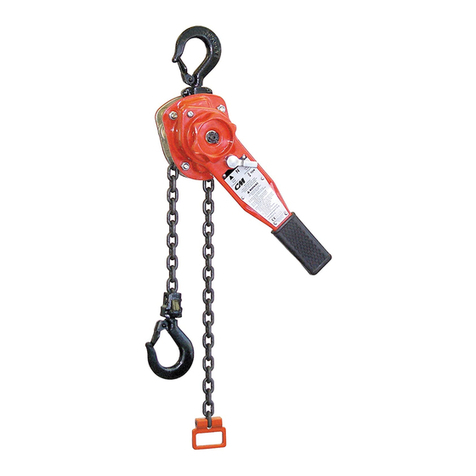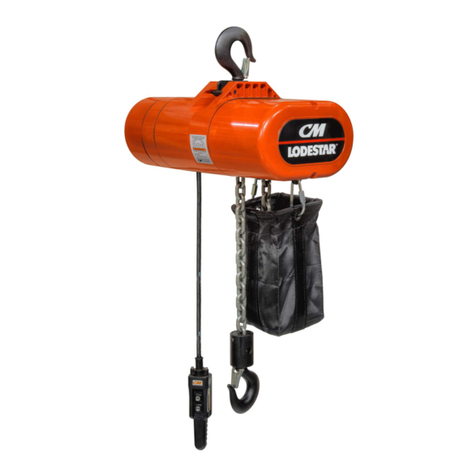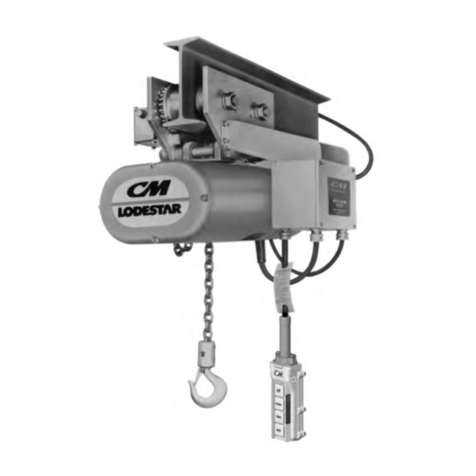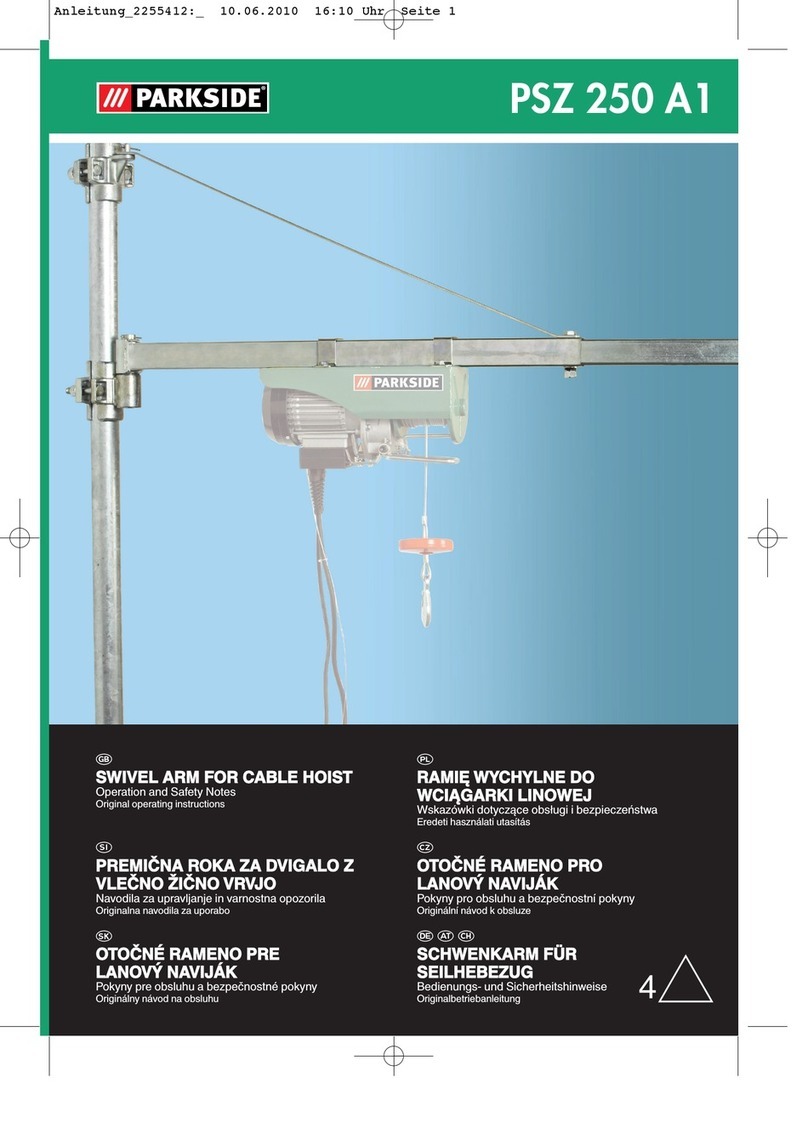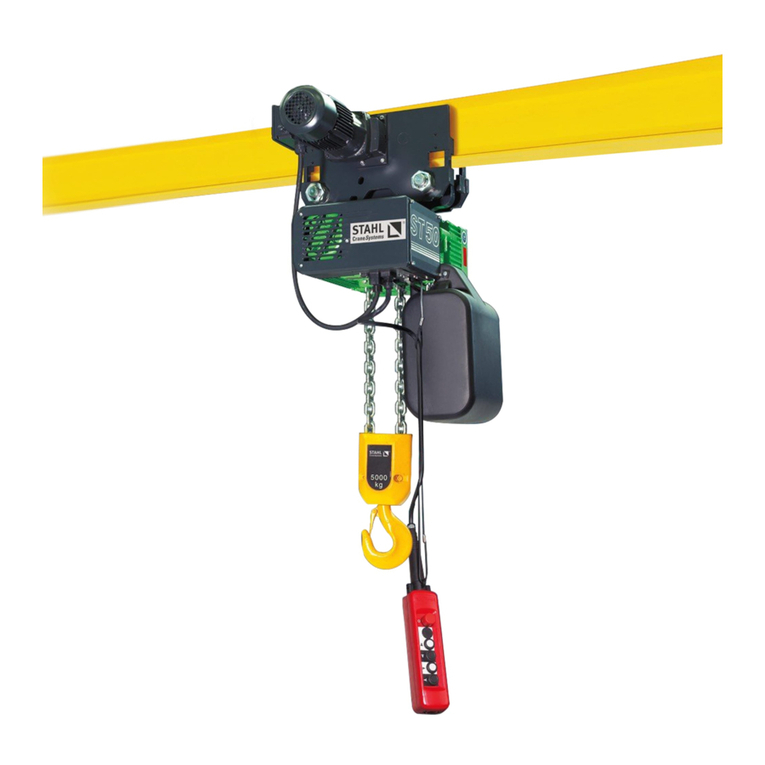
10 P/N: 10001681 (REV AF) August 2020
Failure to properly ground the hoist presents the danger of
electric shock.
TO AVOID INJURY:
Permanently ground the hoist as instructed in this manual.
Operate hoist over the entire length of its rated lift, checking upper
and lower limit switches for correct operation as follows:
1. Press (UP) control and raise the lower hook until top of hook
block is about 12 inches (305 mm) below the hoist.
2. Cautiously continue raising the hook until the upper limit
switch stops the upward motion. The upper limit switch is
set at the factory to stop the hook block 8 links from the
bottom of all hoists.
3. If adjustment is necessary, see page 15.
4. Press(DOWN) control and cautiously lower hook until lower limit
switch stops the downward motion. On hoist operated in the
motor down orientation, maintain a minimum of 24" (610mm) of
chain freely hanging over the side of the hoist.
5. If adjustment is necessary, see page 15.
NOTE: If the hoist is equipped with a chain container/bag,
reset the upper and lower limit switches as indicated on
page 15.
Under no condition should the hook block or load be
permitted to come in contact with the chain container/bag.
If contact is made, the function of the chain container can
be interfered with and its fasteners imperiled.
NOTE: When chain bag is filled to capacity the bag must be
no more than 75% filled.
OPERATING INSTRUCTIONS
GENERAL
1. The Load-limiter is designed to slip on an excessive overload.
An overload is indicated when the hoist will not raise the load.
Also, some clutching noise may be heard if the hoist is loaded
beyond rated capacity. Should this occur, immediately release
the £(UP) control to stop the operation of the hoist. At this
point, the load should be reduced to the rated hoist capacity
or the hoist should be replaced with one of the proper capacity.
When the excessive load is removed, normal hoist operation is
automatically restored.
CAUTION: The Load-limiter is susceptible to overheating
and wear when slipped for extended periods. Under no
circumstance should the clutch be allowed to slip for more
than a few seconds.
Due to the above, a hoist equipped with a Load-limiter is not
recommended for use in any application where there is a possibility
of adding to an already suspended load to the point of overload.
This includes dumbwaiter installations, containers that are loaded
in mid-air, etc.
HOIST
1. Before picking up a load, check to see that the hoist is
directly overhead.
2. WHEN APPLYING A LOAD, IT SHOULD BE DIRECTLY UNDER
HOIST OR TROLLEY. AVOID OFF CENTER LOADING OF
ANY KIND.
3. Take up a slack load chain carefully and start load easily to
avoid shock and jerking of hoist load chain. If there is any
evidence of overloading, immediately lower the load and
remove the excess load.
4. DO NOT allow the load to swing or twist while hoisting.
5. DO NOT allow the load to bear against the hook latch.
SAFE OPERATING INSTRUCTIONS
AND PROCEDURES
For safety precautions and a list of Do’s and Do Not’s for safe
operation of hoists, refer to page 3.
1. Permit only competent personnel to operate unit.
2. When preparing to lift a load, be sure that the attachments
to the hook are rmly seated in hook saddle. Avoid off center
loading of any kind, especially loading on the point of hook.
3. Do not allow the load to bear against the hook latch. The latch
is to help maintain the hook in position while the chain is slack
before taking up slack chain.
4. Do not wrap the load chain around the load and hook onto itself
as a choker chain. Doing this will result in:
a. The loss of the swivel effect of the hook which could
result in twisted chain and a jammed lift wheel.
b. The upper limit switch, if so equipped, is bypassed
and the load could hit the hoist.
c. The chain could be damaged at the hook.
5. Before lifting load, check for twists in the load chain.
On double reeved units A twist can occur if the lower
hook block has been capsized between the strands
of chain. Reverse the capsize to remove twist.
6. On single reeved chain hoist used in conjunction with
head blocks and ground support systems, check for twists
between the hoist and head block. Twisted load can result
in a jammed liftwheel.
7. Do not use this or any other overhead materials handling
equipment for lifting persons.
8. Do not load hoist beyond the rated capacity shown on hoist
identication plate or on the hoist motor housing cover or hoist
back frame cover. Overload can cause immediate failure of
some load-carrying part or create a defect causing subsequent
failure at less than rated capacity. When in doubt, use the next
larger capacity CM Lodestar Hoist.
9. Warn personnel of your intention to lift a load in the area.
Tie off the load with auxiliary chains or cables before access
to the area beneath the load is permitted.
10. Do not operate hoist at unusual extremes of ambient
temperatures above 150º F (60º C) or below 0º F (-17º C).
STAGE OPERATION
Hoists can be removed from the road case by manual lifting,
or rigged while still in the case and power out.
Manual Lifting – It is recommended that two people be used to the
lift the hoist from the road case. The hoist can be lifted by grasping
the handles (if tted), the end covers, or the load chain. Never pull on
the electrical cable(s) even if equipped with an external strain relief.
When placed on the oor the hoist should be positioned on its side
with the chain pulled away to allow the chain to enter the hoist
without jamming if the hoist is to be operated.
Never operate a Lodestar hoist
while standing on its end as in the
gure to the right.
The hoist may tip over and damage
the casing, but more importantly it
will cause the Lodestar to “drag”
against its brake putting extra strain
on the electric motor.
When running chain “in” the hoist should be laid on its side on the
ground / stage with the chain stretched out along the ground. The
“dead” end side of the hoist should be on the oor. With the hoist








